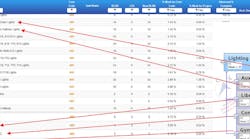Some people, myself included, love autumn. For others, it’s an unwelcome prelude to harsher weather ahead. For wild creatures, it signals a perennial moment in their life cycle – a time to gather and store food or find suitable shelter before winter sets in. For birds, it’s time to migrate to wintering grounds hundreds, sometimes thousands of miles away. Fall migration is happening now and through November, according to the BirdCast Lights Out project, an initiative of the Cornell Lab of Ornithology and other partners that encourages owners and managers of public and private facilities to eliminate or reduce outdoor lighting during this critical period.
Light pollution can have life or death consequences for wildlife. Reliant on long established flyways, they use celestial and terrestrial landmarks to guide them through the night sky as they have for millennia, and are particularly attracted to nighttime illumination from buildings, streetlights, and area lighting. Many birds migrate during the night and light from buildings and other facilities can confuse and disorient them. BirdCast estimates that 365 million to 988 million birds die in collisions with buildings annually. Attraction to outdoor lighting can also cause birds to continuously circle in cones of brightness until they become exhausted and "fall out” of the sky – where they become easy targets for automobiles and predators. (Carolyn Burt, a scientist with the National Science Foundation’s Convergence Research program, provides more insights on light pollution and migrating birds in this blog post.)
To minimize these and other impacts of human-caused light at night, the DesignLights Consortium (DLC) created its LUNA Technical Requirements for outdoor LED products in 2021. By establishing requirements and reporting standards on light distribution, spectral characteristics, and controllability, LUNA identifies energy efficient outdoor LED lighting that minimizes light pollution, provides appropriate visibility for people, and limits negative impacts to the environment. The program helps mitigate light pollution, but also captures energy savings by pointing lighting decision makers to products that offer the right type and amount of light – only where and when it is needed. The DLC’s list of LUNA qualified products recently doubled, helping advocates, regulators, municipalities, and local communities choose high quality lighting that saves energy. The list includes the full model number information for each product and performance data, supporting decision makers with the information they need to pick the right product for their applications.
Since even the best outdoor lighting product can fail to meet these objectives if not applied correctly, the DLC also created an online resource, Seven Strategies to Minimize Negative Impacts of Outdoor Light at Night. Outlining application strategies that go beyond the LUNA product requirements, this downloadable resource is meant to assist energy efficiency program staff, contractors, distributors, and lighting practitioners interested in using outdoor lighting that is both energy efficient and reduces light pollution. During migration seasons, one recommended strategy is switching off or dimming non-essential lighting later at night when pedestrian activity is expected to be lower.
As birds across North America are migrating to winter habitats, now is a perfect time to consider how to mitigate the challenges light pollution adds to these long-distance journeys. Through thoughtful design, minimizing over lighting, selecting the right products, and implementing controls, we can capture the efficiency value of outdoor LED lighting while reducing light pollution for the benefit of wildlife and people alike.
(Leora Radetsky is the DesignLights Consortium’s LUNA Program Director and Senior Lighting Scientist.)




